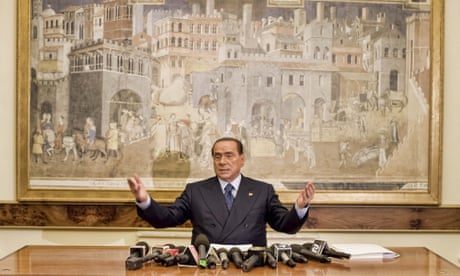
The first and only time Silvio Berlusconi held a news conference at the Italian Foreign Press Association in Rome was in November 1993. The businessman told journalists he had no desire whatsoever to enter politics, and hoped he would never be forced to.
But when the correspondents probed further, particularly about his friendship with Gianfranco Fini, the leader of the National Alliance, a descendant of the neofascist Italian Social Movement, he accused them all of being “communists” – the ultimate insult, from those on the right in Italy – against anyone with leftwing leanings.
Just a few months later Berlusconi won his first election as part of a coalition that included National Alliance.
“He presented as a businessman, knowing full well he was going to enter politics and this was a way of getting exposure in the world’s press,” said Chris Warde-Jones, a photographer who was at the press conference. “But he resented being questioned.”
The three-time Italian prime minister never returned to speak at the Foreign Press Association in Rome. Invitations over the years were refused on the grounds that he found foreign newspapers “offensive”.
All of which makes the association’s move in March into the first floor of Berlusconi’s Rome residence for 25 years, all the more ironic. Correspondents who for the best part of a century were able to work from a headquarters provided by the Italian state are now based in a 16th -century palazzo where the late politician, who died last year, held his most important political meetings – and some of his notorious “bunga bunga” sex parties.
Journalists will stroll along the same corridor where Vladimir Putin played fetch with Dudù, Berlusconi’s much-loved white poodle. Some will scramble to meet their deadlines in the same room that housed Joseph Stalin’s bed – a gift from Putin to his longtime friend. They will visit the bathroom where women invited by Berlusconi to the palazzo posed for mirror selfies.
Berlusconi held sway over Italian politics for almost three decades, and, while he had a hate-hate relationship with the foreign press, he kept them busy. When in Rome, Palazzo Grazioli, which was constantly staked out by huddles of journalists and photographers, was at the centre of it all.
Berlusconi rented the home from its owner, the noble Grazioli family, until 2021, when he moved to the more tranquil Appia Antica area.
Some of the remaining aspects of Palazzo Grazioli give insight into the fears he had for his safety – a number of rooms are fitted with bulletproof windows. A fitted wardrobe shields a “secret” door providing Berlusconi with an emergency escape route.
Rome’s Foreign Press Association, which has more than 300 members, moves in on 25 March following an inauguration on Tuesday by the Italian president, Sergio Mattarella.
That foreign correspondents have an official place to work in their host country is a rarity.
When the association was formed in 1912, correspondents for some 27 newspapers, including the Daily Express and Echo de Paris, worked in a cafe down the road. In 1936, they moved to Via Mercedes in a building provided by Benito Mussolini’s government, a gesture seen as a way for the fascist dictator to keep watch over the foreign press. There they remained until 2001, when they transferred to a building near the Trevi fountain that is now being turned into a five-star hotel.
There was much anguish over finding a new home until Palazzo Grazioli came along, almost by fluke. “We saw about 15 buildings,” said Gustav Hofer, a correspondent for the TV network Arte and member of the association’s management board. “I joked with the property broker: ‘How about Berlusconi’s ex-home?’ He took it seriously and said ‘let me look into it’.”
On first stepping into Palazzo Grazioli, Hofer said it still contained “the spirit of Berlusconi”.
“There was even a piece of paper listing his order of clothing, and tailor measurements, in a wardrobe,” he added. Berlusconi also left behind pieces of old, heavy furniture, which were moved out to make way for bright, open-planned offices, conferences rooms and a bar and restaurant designed by Serena Mignatti, an architect who designed the home in Rome of Radiohead’s Thom Yorke.
“The Italian state is very proud to have the story of Italy told so broadly by people from across the world,” said Esma Çakir, the president of the Rome Foreign Press Association and correspondent for the Turkish news channel NTV. “We have a 360 degrees view of the country, from food and culture to politics and the economy.”
She said the association had received a flurry of requests from people wanting to hold press conferences and other events at Palazzo Grazioli. “It will be a prestigious place to meet,” she added.
While Italy’s far-right prime minister, Giorgia Meloni, is yet to give a press conference to the association, she did attend a recent informal dinner with correspondents, during which she quipped: “I don’t know what Berlusconi would be thinking, from up there … about this bunch of communists, as he would say, moving into Palazzo Grazioli.”
Çakir said: “Being accused of being communists means we are doing our job well, and this is a good thing.”